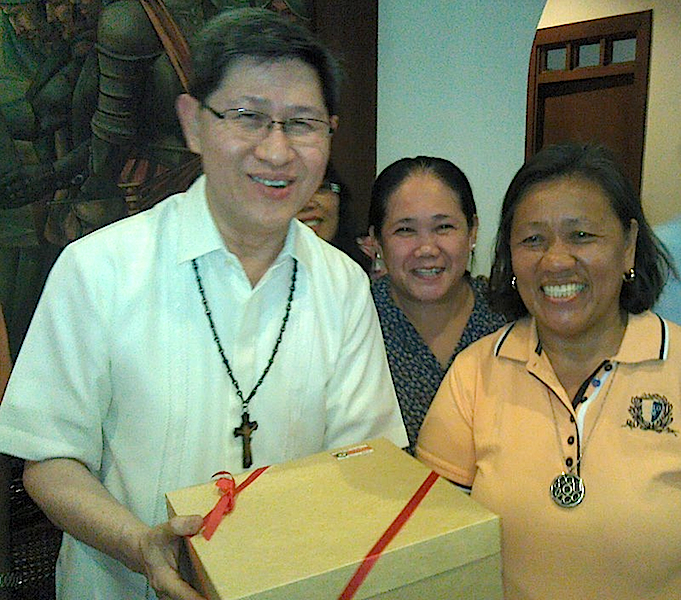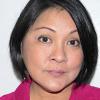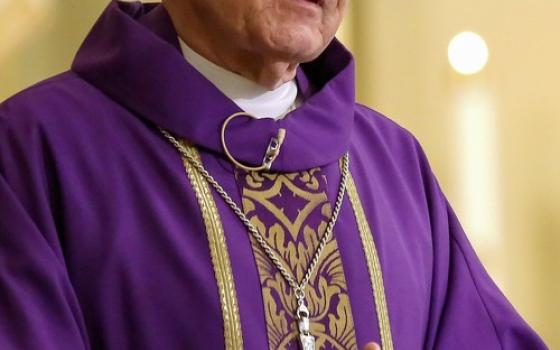
Members of Urban Poor Alliance and leaders of organizations and institution advocating housing and other rights of the poor hand Cardinal Luis Tagle of Manila (left) a box of home-made apple pie at their meeting in the archbishop’s residence Jan. 7. (Rosalio Obnamia)
Before leaving for Rome for the consistory, Cardinal Luis Tagle of Manila listened to suggestions from leaders of poor Manila communities about drawing parishes more closely into their community’s life. They have ideas about how better to include poor families into the life of the church.
“I was overwhelmed,” Tagle told NCR Feb. 9, the day before he left for Rome. He said, "Every time I meet with, not only urban poor, but any member of the poor sector, I am rendered speechless.”
He said leaders of the Urban Poor Alliance (UPAll), people’s organizations in communities served by the Archdiocese of Manila who met with him on Jan. 7, left him “inspired.”
Tagle welcomed the nine leaders accompanied by six officials of NGOs, foundations and institutes that work to uphold housing and other rights for people who live in the so-called slums on land they do not have legal claims to. The groups help with community organizing and training, and they research the communities’ needs versus the impact of government programs and initiatives.
"I’m very much appreciative of their ideas regarding how solutions are to be found," Tagle stressed. "Their (UPAll leaders') coming to me and meeting with me is an invitation for the church to be more present in their lives."
Filomena Cinco, chairperson of Barangay 412, Zone 2 in Legarda district of Manila, presented Tagle a summary of what the church can do for urban poor communities and what these communities can do for the church.
About 125 families live in her community in houses built over the creek (estero). They are daily wage earners working, for example, as street vendors, public bicycle side-car drivers and janitors. About 80 percent are Catholic, and the rest belong to other Christian denominations or are Muslims. Some 75 percent of the residents come from Leyte and Samar in central Philippines, which is still reeling from last November’s typhoon Haiyan.
Cinco, speaking for residents in her own community and others in the archdiocesan territory, told Tagle they want church representatives, especially priests, to visit the poor areas of the parish and talk to residents about their living conditions and concerns of their community.
Cinco later told NCR some priests disapprove of her own creek-side community. "There are priests advocating removal of (settlers) from communities near them saying these are illegal, we’re an eyesore, a threat to safety and other things," Cinco explained. One priest even advised us to just accept relocation in remote provinces even if this means moving children away from school and adults far from their jobs,” the community official said.
A new housing project, Estero de San Miguel, is being built in Manila’s Legarda area and is the national government’s first attempt to build houses for homeless and landless people in the city.
At the meeting with Tagle, she shared the communities' appeal for regular catechism and youth formation programs to encourage young people to go to church. She told Tagle people also want the parish to support community-based livelihood programs or create job opportunities for poor residents.
Residents in Manila communities suggested organizing basic ecclesial communities (neighborhood groups) who could study the Bible together or set up street Masses, Rosary and other prayers. Some adults would like to participate more in church, she explained, but they can’t skip work to do so: no work means no food for the family, no money for school.
On Feb. 8, Tagle told NCR he had presented the concerns and suggestions of communities allied with UPAll to Manila’s Council of Priests. They proposed inviting the community leaders to a dialog “so that they could hear directly from (urban poor), and then pastors can also present their initiatives in their respective parishes.”
“Who knows?” Tagle said. “Maybe that kind of sharing will result in lessons from each other. We can also identify places that are under-served.” He asked UPAll’s dialog group to give him a list of places so visits could be scheduled.
He noted, "Since Vatican II (Second Vatican Council, 1962-1965) the church has been asked not only to be present, but also to be incarnated in different life situations.” It is "good" that concerns the group raised with him were “concerns that priests and pastors should be addressing."
Two auxiliary bishops and 178 diocesan priests with more than 350 religious priests help minister to some 2.43 million Catholics among more than 3 million people living in the archdiocesan territory, according to the latest Catholic Directory of the Philippines.
[N.J. Viehland is NCR’s correspondent in Asia.]




